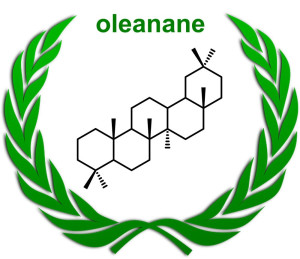By Paul Farrimond
Oleanane is present in only some oils and source rocks. It occurs as two isomers – 18α(H) and 18b(H) – and is typically found as a doublet peak in the m/z 191 mass chromatogram eluting just before the C30 αb hopane. Other peaks can occur in this part of the chromatogram, so oleanane identification is best confirmed by GC-MS-MS in some cases. The 18(α)H isomer is the most thermally stable and is typically dominant in oils and mature source rocks.
Oleananes are used as markers for higher plant input, although they are derived from only some angiosperms (flowering plants). They are not quantitative markers for land plant input, partly for this reason, but also because oleananes are not the only diagenetic products from their various biological precursors in angiosperms; aromatic hydrocarbons may also be formed, the relative abundance of which depend upon marine influence (Murray et al., 1997). Contact between the sediment and seawater during early diagenesis apparently promotes the formation of oleananes – hence their common association with deltaic environments.
The first undisputed fossils of angiosperms are found in the Early Cretaceous, and such plants came to dominate world flora in the Late Cretaceous. Moldowan et al. (1994) reported a corresponding increase in the occurrence of oleananes through the Cretaceous and into the Tertiary and proposed the Oleanane Index (oleanane/[oleanane+C30 αb hopane]) as an age-sensitive parameter. Oleananes have been found in pre-Cretaceous samples, but such occurrences are rare, so their presence in an oil points to a Cretaceous or younger source rock. However, always keep in mind that oil can leach biomarkers such as oleanane from the migration path or within the reservoir (Curiale, 2002).
References:
Curiale J.A. (2002). A review of the occurrences and causes of migration-contamination in crude oil. Organic Geochemistry 33, 1389-1400.
Moldowan J.M., Dahl J., Huizinga B.J., Fago F.J., Hickey L.J., Peakman T.M. & Taylor D.W. (1994). The molecular fossil record of oleanane and its relation to angiosperms. Science 265, 768-771.
Murray A.P., Sosrowidjojo I.B., Alexander R., Kagi R.I., Norgate C.M. & Summons R.E. (1997). Oleananes in oils and sediments: Evidence of marine influence during early diagenesis? Geochimica et Cosmochimica Acta 61, 1261-1276.